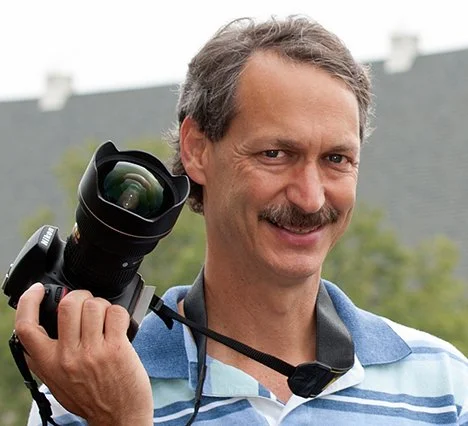When Cincinnati-based photographer J. Miles Wolf was asked to photograph Memorial Hall, it was an opportunity to connect his finely honed craft with a space rich in history, architecture, and emotion.
Miles first discovered photography in college, where a single course set him on a path that would span decades. In the early years of his career, he traveled extensively—capturing the landscapes of the American Southwest and the charm of European cities. His work was exhibited in galleries across the country, but eventually, Miles sought to focus closer to home. Through workshops and collaborative efforts, he refined his ability to photograph architecture with a deep understanding of structure and space.
What sets Miles apart is not just his eye for detail but his process. For the first 30 years of his career, he developed his own film, meticulously preparing every shot with the precision required before the age of editing software. Shooting with large-format 4x5 film taught him patience and attention to detail—skills that would become foundational as he worked alongside interior designers and began reverse-engineering spaces to showcase their most striking qualities. His early focus on art deco architecture fostered a deep appreciation for the intricacies of design, which remains evident in his work today.
Miles' connection to Memorial Hall began when longtime supporter Bill Baumann saw his work displayed at a FotoFocus event and invited him to photograph the building. For Miles, it was the perfect alignment of opportunity and intention. He approached the project with a desire to create images that felt both warm and welcoming—photos that could invite newcomers in and also resonate with those who already know and love the Hall.
“I want to make the interior so inviting that people want to go see it,” Miles shared. “It shows people how beautiful these spaces are. To see that auditorium is very eye-opening.”
He emphasized the challenge and reward of architectural photography:
“You can’t just go to a location and think you’re gonna get it,” he said. “It’s not always bright blue skies, with fluffy white clouds. You’re knocking on doors, climbing on roofs to get the shot—all while balancing the lighting, time of day, and countless other factors.”
Technology has expanded what’s possible. Miles spoke enthusiastically about how drone photography has opened new creative perspectives, particularly for a building like Memorial Hall. Even with decades of experience, these tools allow him to rediscover spaces and compose images in ways previously unimaginable.
Looking ahead, Miles is turning his lens toward nature and landscapes, including an upcoming project with the Behringer-Crawford Museum. While he will always hold a deep connection to architectural subjects, he’s eager to explore storytelling through more personal and environmental imagery.
In all his work, Miles encourages viewers to slow down, look closer, and appreciate the quiet beauty in the details—something Memorial Hall offers in abundance.
—Kyle Fugate


